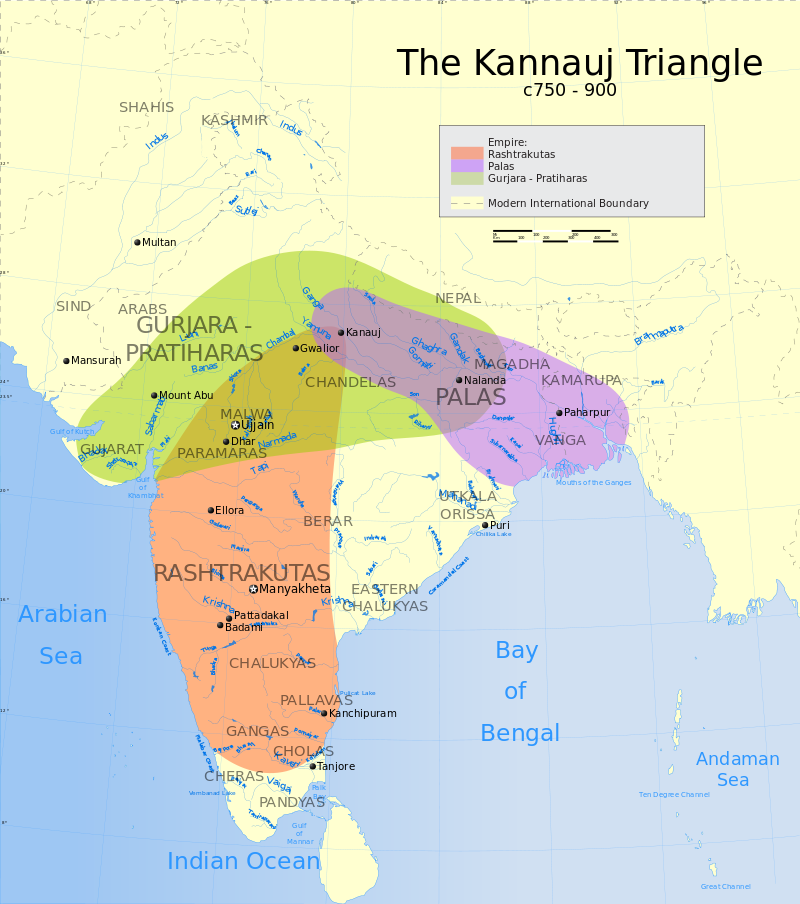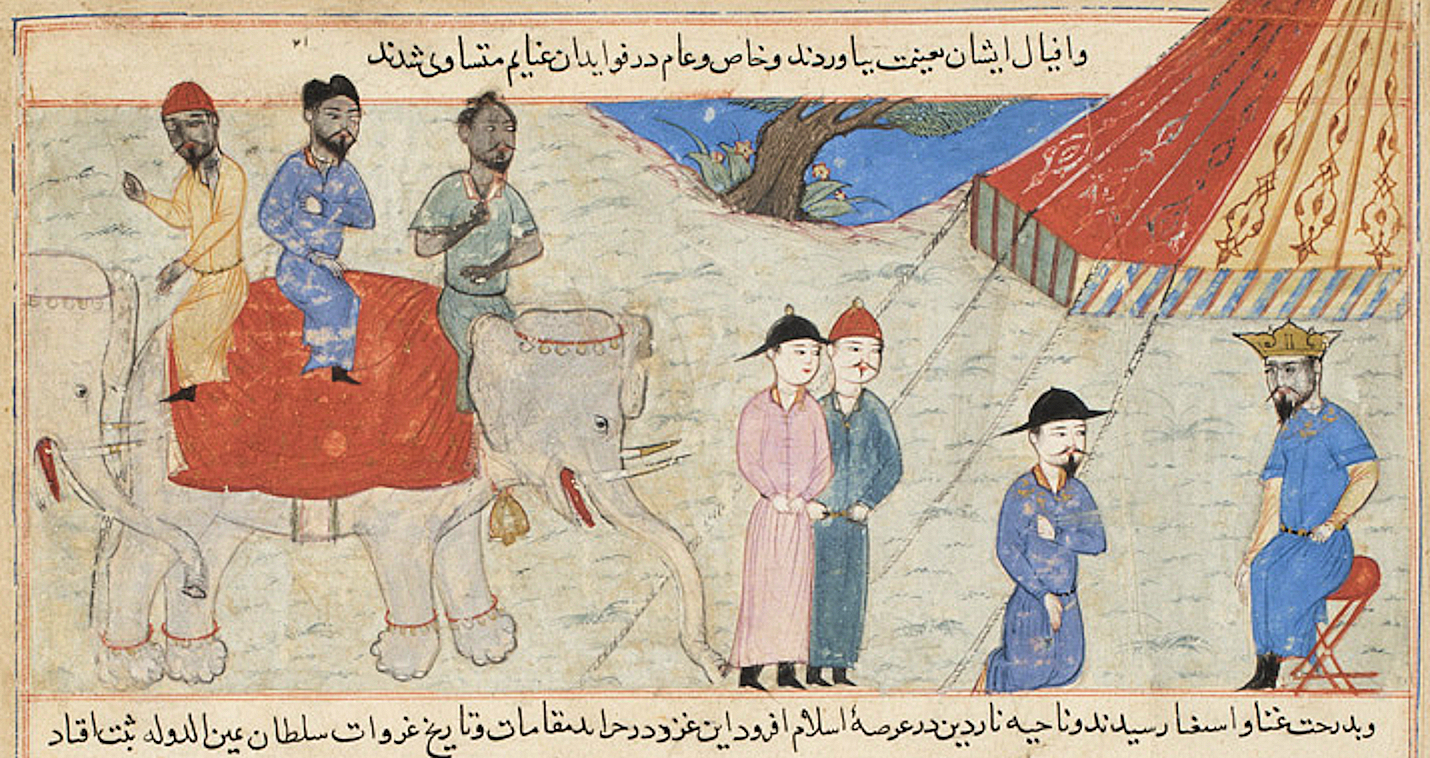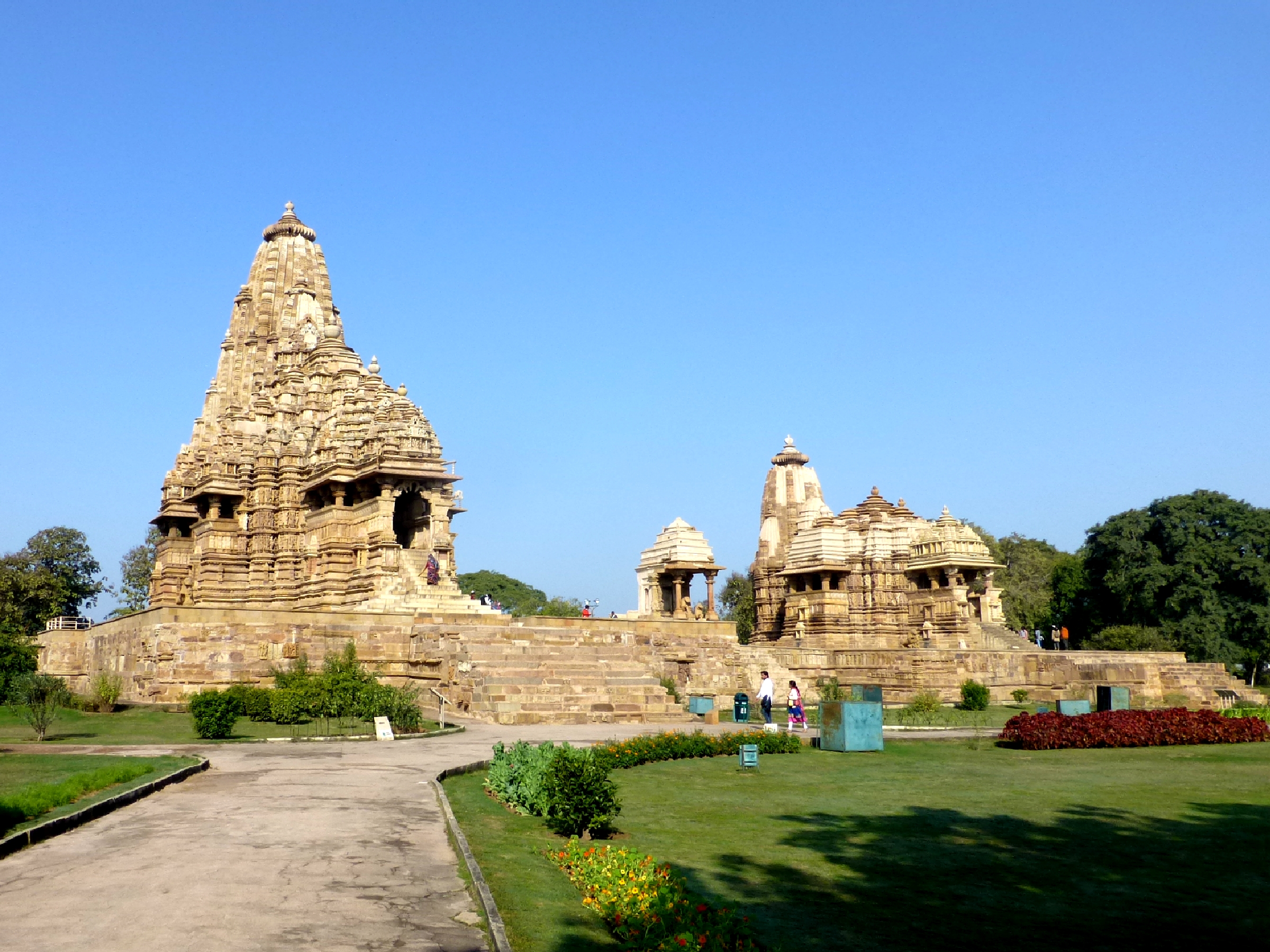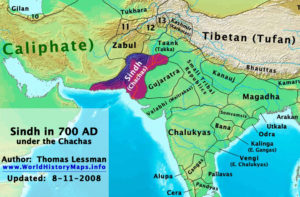
Another Browncast is up. You can listen on Libsyn, Apple, Spotify, and Stitcher (and a variety of other platforms). Probably the easiest way to keep up the podcast since we don’t have a regular schedule is to subscribe to one of the links above!

In this episode Maneesh and Gaurav chat with Jay and Omar Ali and they discuss North Indian politics and power struggles for a vast period from 700 CE to 1200 CE. We touch upon the origins of the Imperial Pratiharas and Palas and discuss the tripartrite struggle for domination of Kannauj between the 3 great kingdoms of Indian subcontinent while a storm brewed up in the west. We also talk about the earlier Arab invasions of Sindh and Punjab and the later Turkic invasions by the Ghaznavids and Ghurids which laid the foundation of Islamicate rule in India.

We will cover the Cultural changes of this period in another episode.
Another Map of the era

Some Links to stuff discussed in this episode:
Al Beruni, Kitab ul Hind https://www.academia.edu/45077160/Al_birunis_Kitab_Ul_hind
Al Baladhuri: Early Islamic Conquests. https://www.researchgate.net/publication/338318331_Arab_Conquests_and_Early_Islamic_Historiography_The_Futuh_al-Buldan_of_al-Baladhuri
One thing which amuses me is the lack of heroes within the Hindutva pantheon from this era. In all probability, the rolling back of Arab forces from India, is perhaps an equivalent achievement to the Franks victories ( over Arabs) around the same era. When Roman forces in Africa and Spain could resist very little, North Indian forces could resist Arabs far better.
Omar has a very relaxing voice. Some observations.
There were no formal Muslim invasions of India outside of Sindh/Punjab before Ghori, but rather periodic raids to extract loot, some of which were successfully repulsed by local forces.
During the Chach rule of Sindh, Majha was ruled by the Punjabi Tankas, who themselves were eventually conquered by the Hindu Shahis, who themselves were soon conquered by the Ghaznavids. The Gujarat Sultanate would later be founded by Tanka converts to Islam.
The Gujjars do not have signs of Hun ancestry, but their geographic distribution maps almost exactly onto the area controlled by the Huns, its quite odd.
The Karkotas of Kashmir in court histories are described as conquering central-asia, iran, afghanistan, and nearly all of India. These claims are considered baseless by virtually all scholars (and most Indian ones as well), very odd to hear them given credence in this podcast.
Even i was surprised but didnt interject at that point – I think Jay was quoting Kalhana not telling it as a literal truth; Though Lalitaditya had contacts with Central Asia – i would say more on exerting limited power or alliances – he clearly had enough clout to be mentioned by the Tang
@ArainGang Pratihara is a Rajput clan not even in Gujjar, and Gurjara not necessarily equals to Gujjar here. Where is the genetic imprint of Gujjar in that region ? On the other hand it is Gujjar who are bit odd.
You claim Gujjar kings as your own(Rajput). Rest assured, the Gujjars will come after your kings.
https://www.outlookindia.com/website/story/india-news-calling-prithviraj-chauhan-a-gurjar-king-is-an-act-of-identity-grabbing-rajput-body/387867
Two can play this game, no?
Lol Saurav – what is your belief about claims to these things ?
LOL. I mean here we aren’t batting an eyelid when we accept that a Bengali, Kannadiga or a Kashmiri power somehow ruled over Kannuaj. I mean can a Bengali or a Kannadiga even find Kannauj on an Indian map? Most probably not.
But its somehow difficult for us to accept that Gujjars ruled over North India. Why? Because deep down we feel they were too lowly to have imperial status. But we wont say it. So they had to be Rajputs. Simple as that.
KK Muhammad of ASI recounts on how the famous dacoit Nirbhay Gujjar helped with reconstruction of Gurjara-Pratihara temples in Bundelkhand. Gujjars in Bundelkhand are in general quite religious folks and patronize brahmins and temples (with their limited means). Something doesn’t feel right when they are caste hierarchy wise lower than Ahir-Kurmis. Sort of like Jats that are universally considered quite low.
There is a temple dedicated to Nirbhay Gujjar (I remember the deity is Shiva but there is a murti of Nirbhay) in Bundelkhand with a following across caste lines.
Since the Gujjar dacoit imperial rule over Chambal ended about 15 years ago. Thakurs, and Ahirs (Samajwadi) have destroyed the land with illegal mining.
I guess the Gujjars falling behind Kurmis-Ahirs is their relative low numbers. Most of them converted to Islam and are in today Pakistan. The rest were pushed down by the other OBCs. Low numbers= Low political power. So unlike the other OBCs, they couldn’t scale up their status like Jats. I think they were also notified as a criminal tribe or something during the Brits, which lowered their status further. I could be wrong on that front though.
The other thing is unlike other OBCs, Gujjars do not have any ‘imperial’ lineage. The Jats have Surj Mal, the Ahirs – Krishna, and Kurmis- Lakshman. That’s why they cling on to Gujjara Pratiharas. Their only link to power. And history.
Lol was about the political ownership conflict not the question.
The Caste/Varna angle aside (though you make obvious points)- the issue with the Gujjars are descendents of Gurjar-Pratiharas is that rarely do the Pratiharas call themselves Gurjars or Gujjars.
Mainly three theories come in about origins of the Imperial Pratiharas –
1. Remnants of old Kshatriya-Vaisya elites who had been ruling partially for millennia.
2. Consolidation of Hunnic tribes with remnants of Old Kshatriya-Vaisya elites
3. Shudra upstarts who got wrestled power post the collapse of the Empires of Ancient India.
I think 2 doesnt seem believable given the absense of East Asian ancestry in current indian pops.
So i wouldnt be surprised if they were 1 or 2 to be honest.
But even if the Imperial Pratiharas were upstarts – they wouldnt have become pastoralists and farmers to overwhelmingly (to explain them being ancestors of Gujjars). Also Pratiharas elites came from all areas of North India – not specific locations – like Gujjars and Jats who come from only the western portion of North India. Also given the arrival of Turks – why suddenly did the Rajput elites become dominant ? while Gujjars were relegated to Western India ?
Hence I would wager Pratiharas to be ancestors of Rajput’s of the 2nd millenium
1. Remnants of old Kshatriya-Vaisya elites who had been ruling partially for millennia.
by vaisya elite do you mean samudra gupta and others of the gupta dynasty. were they vaisyas?
I dont know why i am fighting this, when i am not even a Gujjar. But here goes nothing…
Why is it so convoluted to have multiple theories about their origin? And why do Pratiharas have 2 be ancestors of Gujjars or Rajputs? Was Shivaji an ancestor of Marathas? Or Ottomans of Turks?
The Pratiharas capital was Ujjain, which is not out of a realm of possibility of having Gujjar population. Its not Tamil Nadu. So the simple theory is they got power , conquered Gujarat and Rajputana (Nagabhata himself was a contemporary of Bapa Rawal, so Rajputs existed alongside Gujjars). And rechristened their Empire as Pratihara.
When they fell, their Rajputs feudatories got independence, and they in turn became the Western elite(again), and faced the Turks. What is so surprising in all this, that we have to come up with multiple theories?
Saurav, you know it quite well that fight over imperial Pratiharas is not about intellectual Varas or heritage but ancestry –
Eg: I do no descend from either the Peshwas (with whom i share my subcaste) nor the 96k Marathas. But i can claim cultural inheritance from both the Bhosale Rajas and the Bhat Peshwas – I dont think that is the claim made by either Gujjars or Rajputs.
I will leave it at that – i have no strong opinions though I have an opinion. I am not going to take sides in the KangWars
I wasn’t being sarcastic or mean Gaurav. Apologies if it came out that way. Nor do i care whether Pratiharas were Rajputs or Gujjar. I am just curios as to what’s so improbable of Pratihars being Gujjar as opposed to Rajputs.
I didnt think you were being mean Saurav,
I dont think its that “very” improbable that Imperial Pratiharas were ancestors of Gujjars. Just that I favor the hypothesis 1 instead of 2/3.
2=> i think has no basis in its origin – which i referred to in the podcast as well – i couldnt find any reason to support Hunnic origins of Pratiharas.
3=> I can see the argument – i just dont happen to find it convincing for a number of reasons (none of them being very strong)
One glaring mistake I made here is that I have described the Chandellas as the feudatories of the Rashtrakutas, which was not the case. They were feudatories of the Pratiharas. Apologies.
About the conquest of Lalitaditya.
Most information about this comes from Kalhana’s Rajatarangini. Mark Aurel Stein, who edited this text, argued that only Lalitaditya’s victory over Yashovarman and the subsequent conquest of Kannauj and Bengal (Gauda) are historically accurate. But Hermann Goetz believes that the entire account of Kalhana is historically accurate. For more information, read Andre Wink’s Al-Hind Vol-1 (especially Pg 244)
Interesting background on historical caste discrimination faced by ezhavas in kerala.
https://twitter.com/ByRakeshSimha/status/1529669456133488640
Not going to lie, i did chuckle when Omar bhai said these words
‘Bengali adventurer invading Central Asia’
So maybe the British might have been right about the concept of Martial Races all this while?
They always were. There is a reason they ruled over us for that long, No?
No. They ruled Indians because they knew Indians believe a lot of BS about themselves and exploited it. The cultural mindset is what they picked up on and were able to control. Divide and rule is based on the substrate of exploiting the irrational divisions already present.
I notice your jocular tone pushing these streotypes hard. But I do think you believe them a bit too much as inherent with how often you talk about them (this group being weak, strong, cheap, etc.).
Makes sense. Individualism, held as a positive trait, is antithetical to much of Indian historical mainstream thought of the masses.
Well, stereotypes exist for a reason. Plus the Brits ruled us so long, because they did figure out the best.
Ironically, they were also the reason why martial theory was debunked as well. Provided fire arms and training to less-martial ethnicities, lead to the flattening of martial-ness of all ethnicities. Just because it became true post the British, does not mean it was true before that.
Reading with interest all the comments above. My take is that all the 20th/21st century lineage claims by various North Indian castes are patronage games.
Greatly exacerbated by caste incentivisation schemes in Independent India. Add to this the low HDI character of these regions, historical narratives tend to get warped by economic/political cliques.
The historic Gurjaras are distinguished by one unique facet – there exists an attested Gurjara Apabhramsa – which is marked by the absence of an e type conjugation. This has been noted by Schwarzchild.
The formation of a Apabhramsa requires sustained contact between its speakers for the areal features to diverge. This is highly suggestive of the fact that the Gurjaras were indeed a regional group rather than a caste or an occupational community.
Subsequent events may have scattered them across the North Indian plains. But at some point they were co-located into a geographic zone for linguistic convergence to happen. Historical sources suggest that the locus of this zone kept moving into India from the Indus into the Malwa regions via Rajasthan.
In general, levels of social capital (whether based on caste, language or region) are higher in southern and western India. British influence is an important consideration here. The preeminent path to modernity in the interior was through military service, so inventing or emphasizing martial roots became important for most castes there. So existing social capital was let go to invent new identities.
The coastal areas were a different story. Interestingly, the group that produced modern India’s most celebrated military leader has never claimed any sort of martial origin.
who are you referring to in ? “India’s most celebrated military leader “
Thimaya perhaps? But then he does come from a ‘martial’ zone.
Or perhaps you consider a typical Parsi quite Martial!
thimmaiyya is a coorgi. the coorgees have given us two chiefs and may other ranks.
Guess he is referring to Sam Manekshaw (??). But then they would be the last remnants of a powerful Indo-Iranian continuum. And fully relevant to the current discussion on Middle Age Kings fighting Islamic incursions….
Wasn;t he from Punjab?
Its Indian army after all, a Bengali even lead it once. So no surprise there…
the indian bengali is an argumentative soul, where as the bangladeshi appears to be martial considering their coups etc.
I mean compared to Indian Bengali, anything will be considered martial…
Gujarat was better when it was more culturally linked with Rajasthan. Saurasthra> main Gujarat. Gandhi finished the castration job. Interestingly, despite low army contribution- villages can be pretty violent and territorial disputes can definitely get ugly. Communal riots are also not as uncommon as they should be. Though, historically these issues are much much better. Lack of alcohol and relatively limited gun culture also contributes.
Under Modi, more youths trying to join army. But recruitment is still really bad.
https://indianexpress.com/article/opinion/columns/debates-over-aurangzeb-shivaji-rana-pratap-prithviraj-chauhan-not-about-good-bad-history-but-tussles-over-memory-7949519/
“ The battle over motives in history is one, that for the life of us, we could not understand. Was the desecration of temples, whether by Mahmud of Ghazni or Aurangzeb, driven by the motives of asserting political power or economic gain as secular historians want to assert or was it an act of religious bigotry? How does one even ascertain this? Would it make a difference? Would it make a moral difference if we said the demolition of Babari Masjid was politically motivated, not religiously motivated? Or as one of our history teachers used to say, he would be even more morally offended by temple desecration if it turned out it was done for mere opportunism rather than out of genuine conviction. It was a way of challenging the unexamined assumption that somehow a deed done under the sign of earthly functionality (power or riches) made it a less loathsome act than if it were done out of piety. At least the fanatic is not destroying lightly. He may be deluded, but he has not destroyed you for a trivial reason.“
The rise of Mehta ji inner-Hindu ?
Hi Gaurav,
As you see, how do you propose to solve muslim extremism issue in india ? Askar Ali (ex muslim) who studied 12 years in madrasas has told very scray things that taught there about Hindus. Swati goel sharma on twitter records love jihad cases which is ongoing issue. stone pelting is issue. placing bounty of nupur is like 7th CE practice which they are doing at that too in india… what to do ? i feel worried about my future generations. do you see any plan on doing complete population exchange in future or ghar vapsi maybe viable option..comment pls this really stresses me out. There are hardly any muslim liberals, one being arif muhaamd